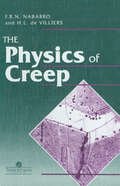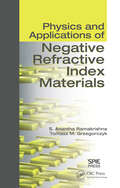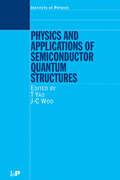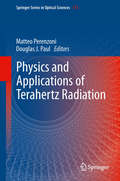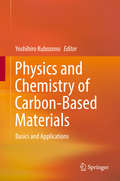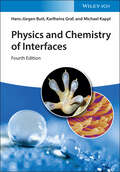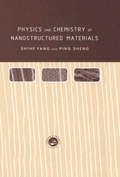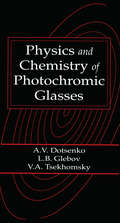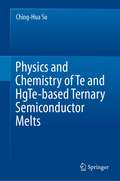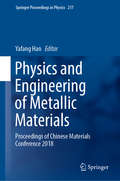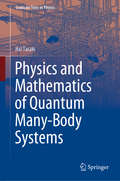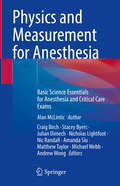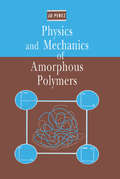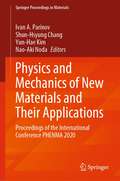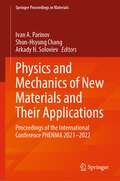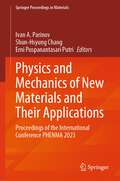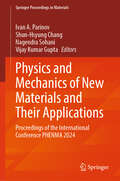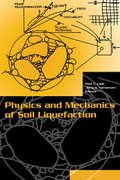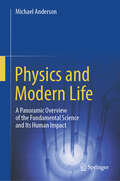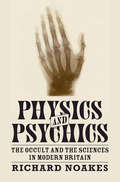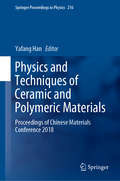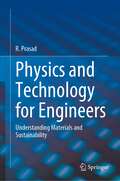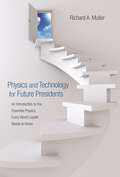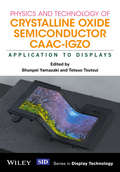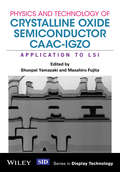- Table View
- List View
Physics Of Creep And Creep-Resistant Alloys
by F R Nabarro F. de VilliersUnique in its approach, this introduction to the physics of creep concentrates on the physical principles underlying observed phenomena. As such it provides a resource for graduate students in materials science, metallurgy, mechanical engineering, physics and chemistry as well as researchers in other fields. Following a brief mathematical treatment, the authors introduce creep phenomena together with some empirical laws and observations. The mechanisms of creep and diffusion under varying experimental conditions are subsequently analysed and developed. The second half of the text considers alloying in greater detail as well as exploring the structure and properties of superalloys and stress effects in these materials.
Physics and Applications of Negative Refractive Index Materials
by S. Anantha Ramakrishna Tomasz M. GrzegorczykEver since the first experimental demonstration was reported in 2000, the interest in metamaterials and left-handed media that exhibit a negative refractive index has increased exponentially. Surveying this explosive growth, Physics and Applications of Negative Refractive Index Materials covers the fundamental physical principles and emerging engin
Physics and Applications of Semiconductor Quantum Structures
by Takafumi Yao Jong-Chun WooWritten by international experts, Physics and Applications of Semiconductor Quantum Structures covers the most important recent advances in the field. Beginning with a review of the evolution of semiconductor superlattices and quantum nanostructures, the book explores fabrication and characterization techniques, transport, optical, and spin-depende
Physics and Applications of Terahertz Radiation
by Matteo Perenzoni Douglas J. PaulThis book covers the latest advances in the techniques employed to manage the THz radiation and its potential uses. It has been subdivided in three sections: THz Detectors, THz Sources, Systems and Applications. These three sections will allow the reader to be introduced in a logical way to the physics problems of sensing and generation of the terahertz radiation, the implementation of these devices into systems including other components and finally the exploitation of the equipment for real applications in some different field. All of the sections and chapters can be individually addressed in order to deepen the understanding of a single topic without the need to read the whole book. The THz Detectors section will address the latest developments in detection devices based on three different physical principles: photodetection, thermal power detection, rectification. The THz Sources section will describe three completely different generation methods, operating in three separate scales: quantum cascade lasers, free electron lasers and non-linear optical generation. The Systems and Applications section will take care of introducing many of the aspects needed to move from a device to an equipment perspective: control of terahertz radiation, its use in imaging or in spectroscopy, potential uses in security, and will address also safety issues. The text book is at a level appropriate to graduate level courses up to researchers in the field who require a reference book covering all aspects of terahertz technology.
Physics and Chemistry of Carbon-Based Materials: Basics and Applications
by Yoshihiro KubozonoThis book includes the fundamental science and applications of carbon-based materials, in particular fused polycyclic hydrocarbon, fullerene, diamond, carbides, graphite and graphene etc. During the past decade, these carbon-based materials have attracted much interest from many scientists and engineers because of their exciting physical properties and potential application toward electronic and energy devices. In this book, the fundamental theory referring to these materials, their syntheses and characterizations, the physical properties (physics), and the applications are fully described, which will contribute to an advancement of not only basic science in this research field but also technology using these materials. The book's targets are researchers and engineers in the field and graduate school students who specialize in physics, chemistry, and materials science. Thus, this book addresses the physics and chemistry of the principal materials in the twenty-first century.
Physics and Chemistry of Interfaces
by Hans-Jürgen Butt Michael Kappl Karlheinz GrafPhysics and Chemistry of Interfaces Comprehensive textbook on the interdisciplinary field of interface science, fully updated with new content on wetting, spectroscopy, and coatings Physics and Chemistry of Interfaces provides a comprehensive introduction to the field of surface and interface science, focusing on essential concepts rather than specific details, and on intuitive understanding rather than convoluted math. Numerous high-end applications from surface technology, biotechnology, and microelectronics are included to illustrate and help readers easily comprehend basic concepts. The new edition contains an increased number of problems with detailed, worked solutions, making it ideal as a self-study resource. In topic coverage, the highly qualified authors take a balanced approach, discussing advanced interface phenomena in detail while remaining comprehensible. Chapter summaries with the most important equations, facts, and phenomena are included to aid the reader in information retention. A few of the sample topics included in Physics and Chemistry of Interfaces are as follows: Liquid surfaces, covering microscopic picture of a liquid surface, surface tension, the equation of Young and Laplace, and curved liquid surfaces Thermodynamics of interfaces, covering surface excess, internal energy and Helmholtz energy, equilibrium conditions, and interfacial excess energies Charged interfaces and the electric double layer, covering planar surfaces, the Grahame equation, and limitations of the Poisson-Boltzmann theory Surface forces, covering Van der Waals forces between molecules, macroscopic calculations, the Derjaguin approximation, and disjoining pressure Physics and Chemistry of Interfaces is a complete reference on the subject, aimed at advanced students (and their instructors) in physics, material science, chemistry, and engineering. Researchers requiring background knowledge on surface and interface science will also benefit from the accessible yet in-depth coverage of the text.
Physics and Chemistry of Nano-structured Materials
by Shihe YangThe development of nanostructured materials represents a new and fast evolving application of recent research in physics and chemistry. Novel experimental tools coupled with new theory have made this possible. Topics covered in this book include nanocrystals, semiconductor heterostructures, nanotubes, nanowires, and manipulation and fabrication tec
Physics and Chemistry of Photochromic Glasses
by Alexander V. Dotsenko Leonid B. Glebov Victor A. TsechomskyPhotochromic glasses are among the most widespread types of glasses, due largely to their popular use in sunglasses. These glasses are used not only in sunglasses, but also in various opto-electronic devices that have been developed and produced throughout the world. Until now, information about photochromic glasses has been widely dispersed in the literature, much of which was published in Russian and therefore of limited accessibility to the Western world. Physics and Chemistry of Photochromic Glasses brings together the combined knowledge and understanding of photochromic glasses from these publications. Coverage includes the structure, optical properties, coloration and bleaching mechanisms, technology, and metrology of these interesting materials.
Physics and Chemistry of Te and HgTe-based Ternary Semiconductor Melts
by Ching-Hua SuThis book reviews the experimental measurements of density, thermal conductivity, viscosity, and electrical conductivity on the binary, pseudo-binary melts of the most advanced IR-detector material systems of HgCdTe and HgZnTe as well as the theoretical analyses of these results. The time-dependent measurements on the relaxation behavior of the thermophysical properties during rapid cooling of the melts were also performed to elucidate the characteristics of the structural fluctuation and transition of the melts.The author shows his research results which extend understanding of the solidification process in order to interpret and improve the experimental results of crystal growth and enhances the fundamental knowledge of heterophase fluctuations phenomena in the melts so as to improve the melt growth processes of all the semiconductor systems.An in-depth study on the thermophysical properties and their time-dependent structural dynamic processes taking place in the vicinity of the solid-liquid phase transition of the narrow homogeneity range HgTe-based ternary semiconductors as well as the structural analysis of the alloy homogenization process in the melt is needed to understand and to improve the crystal growth processes.This book is intended for graduate students and professionals in materials science as well as engineers preparing and developing optical devices with semiconductors. The theory of heterophase fluctuations of liquids is applicable to any many-body systems including condensed-matter physics and field theory.
Physics and Engineering of Metallic Materials: Proceedings of Chinese Materials Conference 2018 (Springer Proceedings in Physics #217)
by Yafang HanThis book gathers selected papers from the Chinese Materials Conference 2018 (CMC2018) held in Xiamen City, Fujian, China, on July 12–16, 2018. The Chinese Materials Conference (CMC) is the Chinese Materials Research Society’s most important conference series and has been held annually since the early 1990s. The 2018 edition consisted of 32 domestic symposia, 2 international symposia and 1 international materials forum. This proceedings book covers the fields of powder metallurgy, advanced aluminum alloys, advanced magnesium alloys, superalloys, metal matrix composites, space materials science and technology, as well as nanoporous metal materials, and presents recent original research findings from more than 300 research groups at various universities and research institutes.
Physics and Mathematics of Quantum Many-Body Systems (Graduate Texts in Physics)
by Hal TasakiThis book is a self-contained advanced textbook on the mathematical-physical aspects of quantum many-body systems, which begins with a pedagogical presentation of the necessary background information before moving on to subjects of active research, including topological phases of matter. The book explores in detail selected topics in quantum spin systems and lattice electron systems, namely, long-range order and spontaneous symmetry breaking in the antiferromagnetic Heisenberg model in two or higher dimensions (Part I), Haldane phenomena in antiferromagnetic quantum spin chains and related topics in topological phases of quantum matter (Part II), and the origin of magnetism in various versions of the Hubbard model (Part III). Each of these topics represents certain nontrivial phenomena or features that are invariably encountered in a variety of quantum many-body systems, including quantum field theory, condensed matter systems, cold atoms, and artificial quantum systems designed for future quantum computers. The book’s main focus is on universal properties of quantum many-body systems. The book includes roughly 50 problems with detailed solutions. The reader only requires elementary linear algebra and calculus to comprehend the material and work through the problems. Given its scope and format, the book is suitable both for self-study and as a textbook for graduate or advanced undergraduate classes.
Physics and Measurement for Anesthesia: Basic Science Essentials for Anesthesia and Critical Care Exams
by Matthew Taylor Andrew Wong Michael Webb Craig Birch Stacey Byers Julian Dimech Nicholas Lightfoot Nic Randall Amanda SiuAnesthesia is a practical, clinically based medical science. Its conduct requires Anesthesiologists and Intensivists to learn and understand the principles of applied physics related to equipment responsible for the clinical care of patients. This book is written primarily for anesthetic registrars/residents and their teachers, to assist with preparation for the post graduate, basic science examinations in anesthesia and critical care medicine. Each topic is systematically covered using first principles, contextual examples, and illustrations to explain and demonstrate complex concepts. This comprehensive book is an up-to-date compilation of these scientific principles that can easily be applied to any operating theatre or intensive care unit around the world.
Physics and Mechanics of Amorphous Polymers
by Jo PerezTopics covered in this text include: structural aspects of polymers; molecular mobility in amorphous solid polymers; non-elastic deformation of solid amorphous polymers; mechanical experiments; interpretation of results; physical ageing of amorphous polymers; and glass transition.
Physics and Mechanics of New Materials and Their Applications: Proceedings of the International Conference PHENMA 2020 (Springer Proceedings in Materials #10)
by Shun-Hsyung Chang Ivan A. Parinov Yun-Hae Kim Nao-Aki NodaThis book presents selected peer-reviewed contributions from the 2020 International Conference on “Physics and Mechanics of New Materials and Their Applications”, PHENMA 2020 (26–29 March 2021, Kitakyushu, Japan), focusing on processing techniques, physics, mechanics, and applications of advanced materials. The book describes a broad spectrum of promising nanostructures, crystal structures, materials, and composites with unique properties. It presents nanotechnological design approaches, environmental-friendly processing techniques, and physicochemical as well as mechanical studies of advanced materials. The selected contributions describe recent progress in computational materials science methods and algorithms (in particular, finite-element and finite-difference modelling) applied to various technological, mechanical, and physical problems. The presented results are important for ongoing efforts concerning the theory, modelling, and testing of advanced materials. Other results are devoted to promising devices with higher accuracy, increased longevity, and greater potential to work effectively under critical temperatures, high pressure, and in aggressive environments.
Physics and Mechanics of New Materials and Their Applications: Proceedings of the International Conference PHENMA 2021-2022 (Springer Proceedings in Materials #20)
by Shun-Hsyung Chang Ivan A. Parinov Arkady N. SolovievThis book presents 50 selected peer-reviewed contributions from the 10th Anniversary International Conference on “Physics and Mechanics of New Materials and Their Applications”, PHENMA 2021-2022 (23-27 May, 2022, Divnomorsk, Russia), focusing on processing techniques, physics, mechanics, and applications of advanced materials. The book describes a broad spectrum of promising nanostructures, crystal structures, materials, and composites with unique properties. It presents nanotechnological design approaches, environmental-friendly processing techniques, and physicochemical as well as mechanical studies of advanced materials. The selected contributions describe recent progress in computational materials science methods and algorithms (in particular, finite-element and finite-difference modelling) applied to various technological, mechanical, and physical problems. The presented results are important for ongoing efforts concerning the theory, modelling, and testing of advanced materials. Other results are devoted to promising devices with higher accuracy, increased longevity, and greater potential to work effectively under critical temperatures, high pressure, and in aggressive environments.
Physics and Mechanics of New Materials and Their Applications: Proceedings of the International Conference PHENMA 2023 (Springer Proceedings in Materials #41)
by Shun-Hsyung Chang Ivan A. Parinov Erni Puspanantasari PutriThis book presents 60 selected peer-reviewed contributions from the international conference Physics and Mechanics of New Materials and Their Applications, PHENMA 2023 (3-8 October, 2023, Surabaya, Indonesia), focusing on processing techniques, physics, mechanics, and applications of advanced materials. The book describes a broad spectrum of promising nanostructures, crystal structures, materials, and composites with unique properties. It presents nanotechnological design approaches, environmental-friendly processing techniques, and physicochemical as well as mechanical studies of advanced materials. The selected contributions describe recent progress in energy harvesting and piezoelectric materials optimization, electromagnetoelastic actuators for nanotechnology research, impedance spectroscopy and study of ceramic materials, catalyst synthesis and control of morphological characteristics, synthesis and study of electrocatalysts for fuel cells. The presented results are important forongoing efforts concerning the theory, modelling, and testing of advanced materials. Other results are devoted to the analysis of technogenic raw materials and different material applications in science, technique and industry.
Physics and Mechanics of New Materials and Their Applications: Proceedings of the International Conference PHENMA 2024 (Springer Proceedings in Materials #3)
by Shun-Hsyung Chang Ivan A. Parinov Vijay Kumar Gupta Nagendra SohaniThe book provides new results of internationally recognized scientific teams in the fields of Materials Science, Physics, Mechanics, Fabrication Techniques and Technologies of Advanced Materials, operating in wide scaling from nanometer to macroscopic range. The developed theoretical and experiment approaches cover prospective manufacture methods of nanomaterials, ferroelectrics, piezoelectrics (environmentally friendly) and other advanced materials and composites. The book discusses fabrication techniques, physics, mechanics, and applications of promising materials and composites. It presents numerous results of theoretical and experimental studies of novel materials and devices with beforehand given and improved structure-sensitive properties, based on the methods of biology, inorganic and organic chemistry, magnetoelectric elasticity, physics of condensed matter and material science. Thus, the book allows one to better understand the modern requirements for advanced materials and composites. The results obtained also include computational algorithms and original hard- and software, used in realization of numerical methods (in particular, finite-element modeling), demonstrating fascinating new advancements for wide spectrum of novel materials (which could be obtained due to reprocessing or using natural materials, wastes, fruits and plants) and devices. The advanced materials with specific properties and novel devices, based on them, show higher and improved properties in comparison with the properties of the competitive publications. In the result, it gives a new knowledge, which is necessary for numerous applications and subsequent development of industry and the methods of management and marketing. The original theoretical, numerical and experiment methods, manufactured devices and set-ups demonstrate significant possibilities in expanding the research of various physical processes and phenomena. They provide different improvements in the study of numerous structure-sensitive characteristics of solids and structures. The book will be useful for students, post-graduate students, scientists and engineers, which research and develop a new generation of nanomaterials and nanocomposites, ferroelectric and piezoelectric materials, other promising structures and compositions with structure-sensitive properties, and various devices, designed on their base and used in different applications of science, technique and technology. Moreover, it will be very interesting for specialists, working in industry, management and marketing. The book is important for unification and development of various expertise, designs and studies. It presents new research methods and scientific results in the Condensed Matter Physics, Materials Science, Physical and Mechanical Experiment, Processing Techniques and Engineering of Nanomaterials, Piezoelectrics and other Advanced Materials and Composites, Computational Methods, numerous applications and developed devices.
Physics and Mechanics of Soil Liquefaction
by Poul V. Lade Jerry A. YamamuroThe workshop aims to provide a fundamental understanding of the liquefaction process, necessary to the enhancement of liquefaction prediction. The contributions are divided into eight sections, which include: factors affecting liquefaction susceptibility and field studies of liquefaction.
Physics and Modern Life: A Panoramic Overview of the Fundamental Science and Its Human Impact
by Michael AndersonThis book introduces physics concepts and principles at a conversant but non-technical level. It also explores technology, with particular focus on two overarching themes that largely define modern life: our intensified use of energy and digital information. These themes take up several entire chapters (“Human Use of Chemical Fuel,” “Computers,” and “Light and Telecommunications”) and substantial parts of several others (e.g., sections on satellites and GPS, telegraph and telephone networks, generators and transformers, nuclear power, and solid-state technologies). The themes of energy and information highlight the pertinence of physics and facilitate a big-picture understanding of how life today differs from that of two hundred or two thousand years ago. The book grew out of lecture notes for a one-semester college physics course for non-science majors, so it could be useful to instructors and students of similar courses. The abundance of material offers some freedom in the design of such a course. However, the author hopes that the combination of conceptual depth and informal tone will appeal to a more diverse audience united by a genuine curiosity regarding science and technology. That audience might include pursuers of continuing education as well as physics majors looking for a lighter conceptual supplement to give context to their more technical coursework.
Physics and Psychics: The Occult and the Sciences in Modern Britain (Science in History)
by Richard NoakesThis is the first systematic exploration of the intriguing connections between Victorian physical sciences and the study of the controversial phenomena broadly classified as psychic, occult and paranormal. These phenomena included animal magnetism, spirit-rapping, telekinesis and telepathy. Richard Noakes shows that psychic phenomena interested far more Victorian scientists than we have previously assumed, challenging the view of these scientists as individuals clinging rigidly to a materialistic worldview. Physicists, chemists and other physical scientists studied psychic phenomena for a host of scientific, philosophical, religious and emotional reasons, and many saw such investigations as exciting new extensions to their theoretical and experimental researches. While these attempted extensions were largely unsuccessful, they laid the foundations of modern day explorations of the connections between physics and psychic phenomena. This revelatory study challenges our view of the history of physics, and deepens our understanding of the relationships between science and the occult, and science and religion.
Physics and Techniques of Ceramic and Polymeric Materials: Proceedings of Chinese Materials Conference 2018 (Springer Proceedings in Physics #216)
by Yafang HanThis book gathers selected papers from the Chinese Materials Conference 2018 (CMC2018) held in Xiamen City, Fujian, China, on July 12–16, 2018. The Chinese Materials Conference (CMC) is the Chinese Materials Research Society’s most important conference series and has been held annually since the early 1990s. The 2018 edition consisted of 32 domestic symposia, 2 international symposia and 1 international materials forum. This proceedings book covers the fields of advanced ceramic materials and polymer materials, and presents recent original research results from more than 300 research groups in various universities and research institutes.
Physics and Technology for Engineers: Understanding Materials and Sustainability
by R. PrasadThis textbook covers the physics of engineering materials and the latest technologies used in modern engineering projects. It has been designed for use as a reference book and course material for undergraduate engineering students. The book was born out of the need for a comprehensive, balanced, and up-to-date guide for teaching physics to beginning undergraduate engineering students and creating examination papers for technical boards and institutes. The text is divided into ten chapters, each with its specific objectives and features. The topics covered include the classification of engineering materials, atomic structure, electrical and magnetic behavior of solids, quantum mechanics, laser technology, nanomaterials, and sustainable development.Authored by a physicist with over 40 years of teaching experience, this richly-illustrated textbook features an abundance of self-assessment questions, solved examples, and a variety of chapter-end questions with detailed answers. The textbook starts from the very basics and is developed to the desired level, thus making it ideal as standalone course material.
Physics and Technology for Future Presidents: An Introduction to the Essential Physics Every World Leader Needs to Know
by Richard A. MullerPhysics for future world leadersPhysics and Technology for Future Presidents contains the essential physics that students need in order to understand today's core science and technology issues, and to become the next generation of world leaders. From the physics of energy to climate change, and from spy technology to quantum computers, this is the only textbook to focus on the modern physics affecting the decisions of political leaders and CEOs and, consequently, the lives of every citizen. How practical are alternative energy sources? Can satellites really read license plates from space? What is the quantum physics behind iPods and supermarket scanners? And how much should we fear a terrorist nuke? This lively book empowers students possessing any level of scientific background with the tools they need to make informed decisions and to argue their views persuasively with anyone—expert or otherwise.Based on Richard Muller's renowned course at Berkeley, the book explores critical physics topics: energy and power, atoms and heat, gravity and space, nuclei and radioactivity, chain reactions and atomic bombs, electricity and magnetism, waves, light, invisible light, climate change, quantum physics, and relativity. Muller engages readers through many intriguing examples, helpful facts to remember, a fun-to-read text, and an emphasis on real-world problems rather than mathematical computation. He includes chapter summaries, essay and discussion questions, Internet research topics, and handy tips for instructors to make the classroom experience more rewarding.Accessible and entertaining, Physics and Technology for Future Presidents gives students the scientific fluency they need to become well-rounded leaders in a world driven by science and technology.Leading universities that have adopted this book include:HarvardPurdueRice UniversityUniversity of ChicagoSarah Lawrence CollegeNotre DameWellesleyWesleyanUniversity of ColoradoNorthwesternWashington University in St. LouisUniversity of Illinois - Urbana-ChampaignFordhamUniversity of MiamiGeorge Washington UniversitySome images inside the book are unavailable due to digital copyright restrictions.
Physics and Technology of Crystalline Oxide Semiconductor CAAC-IGZO: Application to Displays
by Shunpei Yamazaki Tetsuo TsutsuiThis book highlights the display applications of c-axis aligned crystalline indium-gallium-zinc oxide (CAAC-IGZO), a new class of oxide material that challenges the dominance of silicon in the field of thin film semiconductor devices. It is an enabler for displays with high resolution and low power consumption, as well as high-productivity manufacturing. The applications of CAAC-IGZO focus on liquid crystal displays (LCDs) with extremely low power consumption for mobile applications, and high-resolution and flexible organic light-emitting diode (OLED) displays, and present a large number of prototypes developed at the Semiconductor Energy Laboratory. In particular, the description of LCDs includes how CAAC-IGZO enables LCDs with extremely low refresh rate that provides ultra-low power consumption in a wide range of use cases. Moreover, this book also offers the latest data of IGZO. The IGZO has recently achieved a mobility of 65.5 cm2?}V-s, and it is expected to potentially exceed 100 cm2?}V-s as high as that of LTPS. A further two books in the series will describe the fundamentals of CAAC-IGZO, and the application to LSI devices. Key features: * Introduces different oxide semiconductor field-effect transistor designs and their impact on the reliability and performance of LCDs and OLED displays, both in pixel and panel-integrated driving circuits. * Reviews fundamentals and presents device architectures for high-performance and flexible OLED displays, their circuit designs, and oxide semiconductors as an enabling technology. * Explains how oxide semiconductor thin-film transistors drastically can improve resolution and lower power consumption of LCDs.
Physics and Technology of Crystalline Oxide Semiconductor CAAC-IGZO: Application to LSI
by Shunpei Yamazaki Masahiro FujitaThis book describes the application of c-axis aligned crystalline In-Ga-Zn oxide (CAAC-IGZO) technology in large-scale integration (LSI) circuits. The applications include Non-volatile Oxide Semiconductor Random Access Memory (NOSRAM), Dynamic Oxide Semiconductor Random Access Memory (DOSRAM), central processing unit (CPU), field-programmable gate array (FPGA), image sensors, and etc. The book also covers the device physics (e.g., off-state characteristics) of the CAAC-IGZO field effect transistors (FETs) and process technology for a hybrid structure of CAAC-IGZO and Si FETs. It explains an extremely low off-state current technology utilized in the LSI circuits, demonstrating reduced power consumption in LSI prototypes fabricated by the hybrid process. A further two books in the series will describe the fundamentals; and the specific application of CAAC-IGZO to LCD and OLED displays. Key features: * Outlines the physics and characteristics of CAAC-IGZO FETs that contribute to favorable operations of LSI devices. * Explains the application of CAAC-IGZO to LSI devices, highlighting attributes including low off-state current, low power consumption, and excellent charge retention. * Describes the NOSRAM, DOSRAM, CPU, FPGA, image sensors, and etc., referring to prototype chips fabricated by a hybrid process of CAAC-IGZO and Si FETs.
